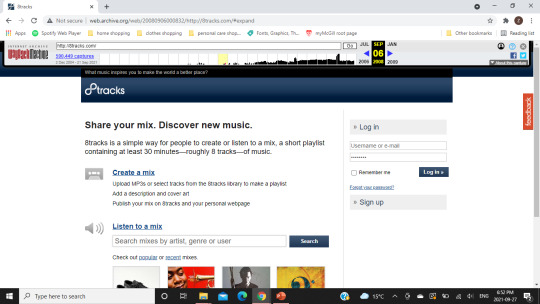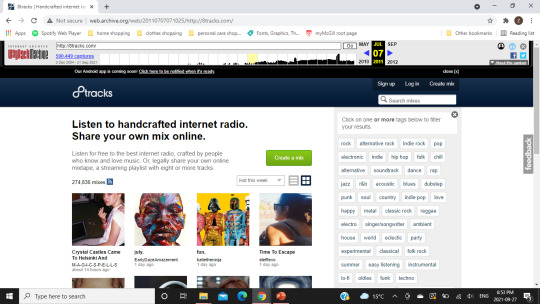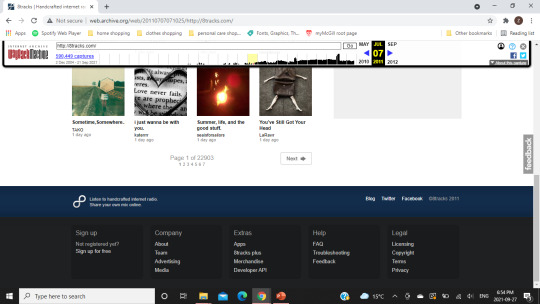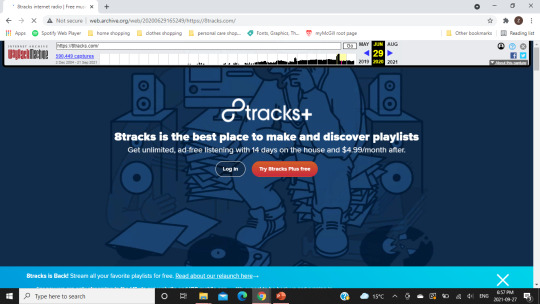A digital portfolio for my work in LLCU 607: Topics in Thought. Tumblr played a large role in my formative digital experiences, so Tumblr seems the appropriate place to compile my work as a Digital Humanities student.
Don't wanna be here? Send us removal request.
Text
Week 10: Immersive Media, Techno-femme/feminized/feminism and Digital Identities
My digital identity, particularly my social media use, has often been a source of internal conflict for me. I’ve never been comfortable with having a representation of myself online, even if I control how I’m represented and who sees me. I deleted my Facebook account after high school, and had no (public) social media for a few years, though I did use some sites like tumblr that didn’t use my real name or image. I’ve since joined Instagram, and I do use messaging apps like FB Messenger and Whatsapp, but I keep my circle small and my accounts private. Whether the account is attached to my name or not, I rarely, if ever, post anything. My internet use is mainly consumptive - Netflix, shopping, etc.
While I certainly value privacy when it comes to “real people,” I don’t seem to extend that to my consumer data. My banking, shopping, communication, and leisure time data is all being quantified and profited from, but I haven’t done much to protect my privacy from that angle. I rely on Google to be an adult: my phone, browser, email, calendar, documents, and on are all Google products. I recently saw someone refer to it as “outsourcing their executive functioning.” While I’m still uncomfortable with Google and other companies knowing so much about me, the convenience outweighs the invasion of privacy.

Despite my misgivings about self-representation online, it was fun to create a bitmoji. I did try to make her look like me, though I'm not sure how successful I was. Having a cartoon avatar is a fun way to circumvent having images of yourself online, while still representing you.
1 note
·
View note
Text
Week 8: AI and Bot-generated Fiction

I think Tumblr was where I was first exposed to Jenny Holzer’s work, but her truisms are already in the perfect Twitter format: one simple line, all caps, no punctuation. The list of truisms I worked from for this bot were written between 1978 and 1983 (https://www.cs.utexas.edu/~field/holzer/truisms.txt). The “GOOD AND EVIL” header image comes from the Tate Gallery, where the truisms read in a scroll across the LED screen. According to them, “In 1982 she blazed these messages across a giant advertising hoarding in Times Square, New York.” Twitter seems like the natural next step. I’m not the first person to come up with this idea, of course, but large-scale electronic broadcast seems very much in the spirit of Holzer’s work.
Using AUTOMATION IS DEADLY as a Twitter bot bio gave me a chuckle.

1 note
·
View note
Text
Week 7: Online Gaming

Full disclosure: I am not a gamer. What I do know of games comes from what bleeds over into the general pop culture sphere. However, Mortal Kombat is a game even I have heard of (even if I tried spelling “kombat” with a c just now), and I’ve seen this character before, though I couldn’t name her. This image, taken from gamedesign.org, features Kitana from Mortal Kombat. According to the Mortal Kombat wiki, Kitana is a princess who, while over 10,000 years old, resembles a woman in her early 20s. In this image especially, Kitana is scantily clad, with her armour carefully arranged so as not to obstruct view of her cleavage. She’s wielding a steel fan, which is used in gameplay as her main attack. While (depending on the which iteration of the game being played) Kitana’s fan is a powerful attack for a powerful character, its feminized associations seem clear. Her hair and the embellishments on her clothes reference different Asian styles, as according to the wiki the character was intended to be Chinese before the game became a combination of many different Asian cultures and time periods. Her name is a combination of the Japanese “Kitsune” and “Katana.”
The Mortal Kombat franchise is massive. The first video game was released in 1992, and there have since been many more games, as well as movies, tv shows, cartoons, card games, online gambling sites, and spin-off games. According to wikipedia, it is the most successful fighting game series in history. The most recent game in the series, Mortal Kombat 11, came out in 2019, and a film was released in April 2021. The franchise remains popular, so I imagine the players include a wide variety of people. Kitana’s image was familiar even to me, someone who knows nothing about gaming. The ubiquity of this sort of depiction of women was something that alienated me from video games, and I think the added layer of Kitana’s racialized depiction should be considered, especially when her image is owned by an American company.

The character design of Kitana has changed somewhat over the 30 years of her existence, but like so many female video game characters, she’s usually wearing very revealing outfits. Her fan is a powerful weapon, but also calls to mind stereotypes of the sexualized and demure Asian woman. From what I’ve read about MK, Kitana often plays an important role in the game’s storyline, and can be a powerful character to play. However, I don’t think that comes across in the character’s presentation.

2 notes
·
View notes
Text
Week 5 - El Paquete
In my literary theory class we’ve begun research for our final papers, so I thought I’d kill two birds with one stone and combine some of that research into a paquete. My paper topic involves Michel Foucault’s conception of the ‘docile body,’ so that’s what my paquete will focus on.
Background on Foucault:
1. https://en.wikipedia.org/wiki/Michel_Foucault - Foucault’s wikipedia page
2. https://www.bibliovault.org/BV.book.epl?ISBN=9780674572867 - biography by Didier Eribon
3. https://michel-foucault.com/key-concepts/ - key concepts of Foucault’s writings
Background on Post-structuralism:
4. https://en.wikipedia.org/wiki/Post-structuralism
5. doi: 10.3817/0383055195 - interview with Foucault on Structuralism and Post-structuralism
Works by Foucault:
6. https://foucault.info/bibliography/ - Chronological bibliography of all Foucault’s works
7. ISBN: 9780307819291 - not a link, but the ISBN for Foucault’s book Discipline and Punish, where he writes about how systems of punishment form the ‘docile body.’
8. ISBN: 9780307819284 - ISBN for Foucault’s The History of Sexuality
9. ISBN 0394529049 - ISBN for Foucault’s “What is an Author?”
10. https://rauli.cbs.dk/index.php/foucault-studies/article/view/4952/5378 - in-depth bibliography of Foucault’s shorter publication
Contemporary takes on Foucault:
11. https://jitp.commons.gc.cuny.edu/finding-fault-with-foucault-teaching-surveillance-in-the-digital-humanities/ - teaching digital humanities students about surveillance using Foucault
12. https://doi.org/10.5749/j.ctvg251hk.19 - similarities between the rise of critical theory and the rise of digital humanities
Misc.:
13. https://foucault.info//foucault-l/threads.html - Online forum discussing Foucault
14. https://rauli.cbs.dk/index.php/foucault-studies/ - Foucault Studies academic journal
15. https://www.fsw.uzh.ch/foucaultblog/ - University of Zurich’s Foucault blog
This list would be directed towards students like me, or those who are interested in learning more about this particular subject. I tried to keep the links on different topics, rather than linking to five different encyclopedia entries on Foucault. I think a collection of links may be curated differently than a collection of files on a USB stick. Linking to a page allows the user to continue on to different sites, whereas a file will remain a static object. I think for the USB stick you would be looking for more discrete units to share, like a tv show, rather than links to pages that are supposed to link elsewhere from there. This would a starting point for Foucault research, but the user would likely continue through the different webpages, requiring an internet connection.
0 notes
Text
Week 4: Web Scraping
I used the first page of the McGill library’s search results for Frankenstein to scrape for data. This offered a few different formats of the novel: print books, ebooks, graphic novels, and videos. I just wanted to test my ability to sort data and use the web scraper, and I think the browser extension is a really good way to get started with this. Between our tutorial in class and the demonstration videos on its website, I found webscraper.io fairly easy to use. Here’s how I set up my search:

It took me a minute to figure out how to scrape each item without going onto their individual search result page, but once I did it was easy to read the data.
Here are the results in a CSV file. (Without a Microsoft Office subscription I wasn’t able to do anything with this file, including copying the contents. Another format to download the results would be helpful.)

I also liked how you could have the relationships visualized in a graph.

My example is pretty simple, but I can see how this graph would help keep the information organized as your scraping got more complex. That said, I can also see how it may be more useful to researchers to use more specific or complex web scraping programs. The browser extension is accessible to those (like me) who don’t have a lot of computational experience, but depending on what your research question is, webscraper.io may not be in-depth enough.
I think this is a useful tool to use in digital humanities research. It is a fairly simple process that creates large amounts of data that are easy to work with. It could be especially interesting to look at social media like Facebook or Reddit using this method.
2 notes
·
View notes
Text
Week 3 blog post: Web Archive
I chose to look at the music streaming website 8tracks, since I remember using it around a decade ago and I was curious to see how it’s changed. Visiting the current website, a banner pops up proclaiming their triumphant return - just in the US, with service to Canada expected to resume shortly. Unaware of what was going on with the company since I stopped using it, I visited the 8tracks blog which chronicles their ‘final’ shutdown at the end of 2019 and subsequent return in April 2020. The post goes into a fair amount of detail about 8tracks’ successes and missteps as a business, and sheds some light on the changes we can see on the homepage through time.

The earliest screenshot shows the website as it was in September 2008, shortly after it launched. The two functions of the site are clear: make a playlist or listen to a playlist. The format almost looks like an early version of Facebook, down to the blue and white logo. 8tracks’ fan base grew quickly. According to their blog, innovations like categorizing mixes by mood and allowing for unique cover art set them apart from their competitors.


The next screenshots come from 2011, which would have been the peak of my usage of the site. Social media definitely has more of a presence than in the 2008 shots. You’re encouraged in various places to share your mix elsewhere online. There’s a large cloud of genres to choose from on the right-hand side, and I remember really enjoying features like this, that let me easily discover new music. Looking at the bottom of the page, there’s links to things like social media, terms and conditions, and company information. Compared to the 2008 page, it looks solidified as a business.

Next is the page in 2015. I, among many other users, had moved on to other music services. The blog post describes a reluctance at 8tracks to be acquired by a larger company - Google made an offer at one point. Other companies, however, offered conveniences in streaming that 8tracks did not. While you can listen to playlists on 8tracks, you can’t listen to one particular song on demand. The screenshot shows an even larger focus on social media - there should be a Google log-in next to the Facebook one but I didn’t give it time to load. They had developed mobile apps at this time, which you can see on the top bar. They’re also highlighting festival music, which has always been a popular category/aesthetic on the site.


Finally, I took a screenshot from June 2020, shortly after 8tracks was resurrected from the dead by an angel investment group. Now we have the introduction of 8tracks+, a paid streaming service to compete with Spotify. Interestingly, the current 2021 version of the site looks pretty much the same, but with no mention of 8tracks+. The colour scheme and logo have remained similar over time, but the website now has line drawings of people listening to music in the background. The cloud of genre and mood tags from the 2011 screenshot has returned, this time to the bottom of the page.
It’s interesting to compare the goodbye post from the blog to the visible changes on the website over time. The financial struggles faced by the company for the majority of its life show through the public face of its site.
1 note
·
View note
Text
Week 2 blog post: Decolonizing the Web
In looking at examples of digital colonialism, I came across Michael Kwet’s essay on “e-education” in South Africa. Standardized testing in South African schools showed poor test scores, despite more government spending in education than any other sector (Kwet). In 2015, the government launched Operation Phakisa Education to address the identified problems in the South African school system. The OPE website lists four main objectives: devices and connectivity, teacher professional development, digital content development and distribution, and monitoring and evaluation. Devices like laptops and tablets are distributed to schools. Data analytics create individual profiles for every student, adapting the curriculum to individual lesson plans. Teacher absenteeism and failure to stick to the curriculum were identified as problems in the education system, so their attendance and compliance to the curriculum is also tracked. School administrators, as well as corporations and the South African government, can access a multitude of data on test scores, performance, and personal information including political affiliation. Kwet points out the issues in this sort of big data surveillance, and gives many examples of historic and current digital surveillance of South Africa. Computational tools of oppression have a long history in South Africa. Kwet uses a quote from Kayyali: “IBM created, maintained, and provided the technological equipment to power the computerized national identification system that helped the apartheid regime denationalize the country’s black population” (2015). An online education system that tracks both student and educator unfortunately echoes that same system, as these schools have a majority black student body and staff.
Kwet offers some suggestions on how to mitigate the surveillance aspect of e-education. Because the security risks of free and open-source software can be evaluated by anyone, security experts endorse its use instead of proprietary software—in this case, the software used by the OPE is owned by Microsoft. He gives examples of alternatives to privacy- or security-compromised products, like using Tor as a web browser instead of Google Chrome. I think these are good places to begin, but extremely unlikely to be undertaken on any kind of scale. It seems the OPE is set up both as an e-education system and as a surveillance system, and to not use it to monitor students and teachers defeats its purpose for the government. I’m not sure it’s possible to have a national education system online without these problems.
Michael Kwet’s essay: https://firstmonday.org/ojs/index.php/fm/articl e/view/8054/6585
Operation Phakisa Education website: https://www.operationphakisa.gov.za/operations/Education%20Lab/pages/default.aspx
1 note
·
View note
Text
Week 1 blog post
Like I mention in the description for this blog, Tumblr played a huge role in my awareness of internet culture. The Internet in general, and Tumblr specifically, opened a world to me beyond my small-town Canadian experience. There were ideas, aesthetics, and politics that I learned about for the first time, and I’ll always regard that learning as a positive thing. I also have a lot of anxiety about the Internet, from issues of personal privacy to the way social media shapes political movements. I find there’s a tension between people shaping the web while the web shapes us.
I think this course will be a good way to explore that tension. I’m unsure exactly what my research interests are, but I know I want to look at issues of representation in the digital world. During my undergrad I wrote about the #MeToo movement in Digital Humanities, and I’d definitely like to continue to turn that critical eye on other digital spaces. I’m especially interested in the upcoming class topics like decolonizing the web and techno-feminism. I think this class will help me put the Internet in an academic context.
2 notes
·
View notes